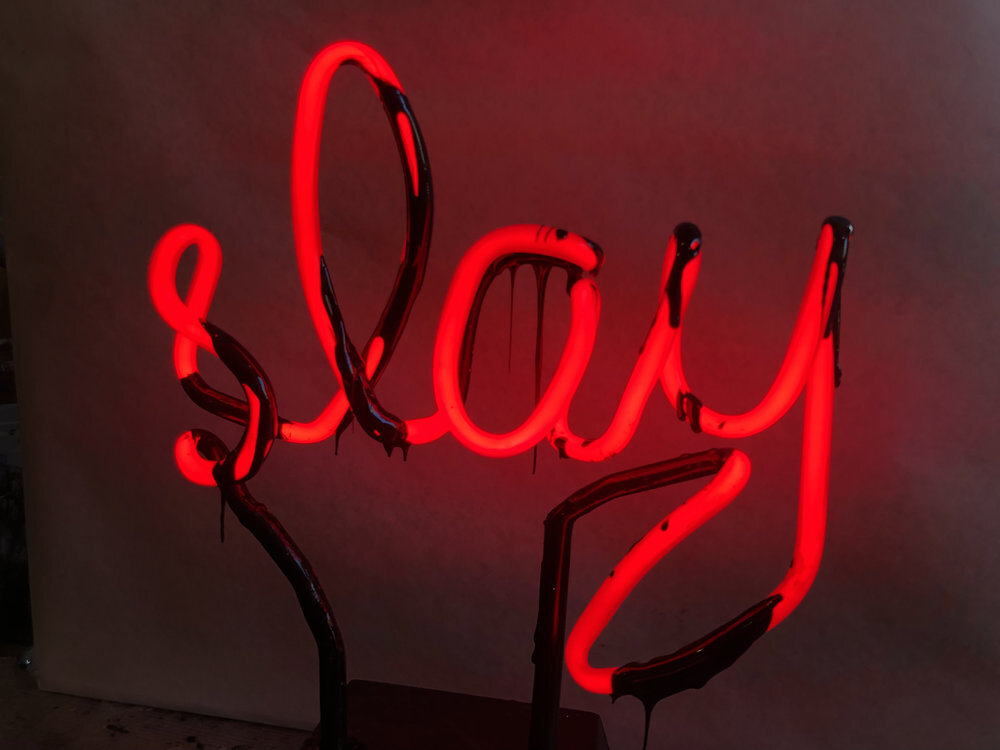Glowing Neon and the Invisibility of Whiteness
July 26, 2018
My first impression of Meryl Pataky's untitled solo show at Stephanie Chefas Projects in Portland was a sense of corrupted beauty. Gorgeous glowing tubes of color caked in a viscous, dripping black fluid. All throughout the show, gooey drips wrapped around curved glass, hugging it tight, clinging against gravity in some places, pooling serenely in others.
LaBrea I
Meryl explained at the show how a neon transformer will leak tar at the end of its life and that this slow death is analogous to the resin in her latest work. She counts recent oversaturation of neon art via insta-aesthetics, misappropriation of fellow neon artists, and the exploitation of neon aesthetics by corporations such as Urban Outfitters, Amped & Co., and Asos as motivation or inspiration for this show.
Untitled
One wall features an array of 4 angularly arranged 48 inch tubes of primary colored neon, caked in the dripping black resin. The electrical cords and transformers are all exposed, smartly refering to their own existence as constructions of material-- glass, wires, electrical cord casing, plugs, resin, pigment. Meryl says, "The work has become self-aware. It knows how ubiquitous it is and yet so misunderstood." In the corners of the room on pedastels are two miniature droopy palm trees, also treated with the same quick cast resin. On the back wall is a glass cinder block affixed with yellow neon and more dripping tar. As a whole, the show is a powerful meditation on material and the process of making things with hands.
Slay (Made in the U.S.A.)
Between the dripping palm trees stands what is unmistakably the centerpiece of the show-- a flickering red neon piece that spells out the word 'slay' in cursive script. Along the tube is tar-like black pigmented resin, the drips dried mid-air. I asked about the inspiration behind the piece, and she said that she is intentionally "ripping off," right down to the font, a particular piece that has been mass produced by a popular lifestyle brand. And also that "the tar represents a death of something." It is ostensibly a commentary on capitalism. She says, "When something is appropriated and over-saturated, it's message or original authenticity is diluted."
I asked whether she had considered the racial implications of her use of the word 'slay,' a term that originated in NYC Black Ballroom culture, and which entered the popular lexicon just a couple short years ago. "I'm not sure I can say that I had any racial issues in my mind while conceptualizing or making the piece," she admits. The piece in question has been titled "Slay (Made in the U.S.A.)", which presumably refers to the exploitation of neon art by a corporation reliant upon cheap foreign labor. Although a valid critique of capitalism, the use of "Made in the U.S.A." comes off as Nationalistic at a time when Nationalism is closely aligned with Xenophobia. Sadly, the work and the title both miss opportunities to highlight critical issues: that popular aesthetics routinely plunder black cool, and that black cool is uniquely American.
Meryl, a white woman living in Oakland, has made a piece about artistic appropriation and exploitation by, herself, appropriating a term popularized by Beyoncé in Formation-- a song and video that is, as Madison E. Johnson writes in The Harvard Crimson, "momentous because in its rejoicing it is, unmistakably, by and for black people-- especially for black femmes." Since Formation's release 2 years ago, 'slay' has been endlessly appropriated by white queers and white women. Johnson again tells it bluntly:
“When Beyoncé says ‘slay,’ she means that all the black folks in the video look fly as hell, obviously. But she also means that she is putting her body and her art into the spaces that have inentionally betrayed her— the southern plantation, the hung portraits, the floodwaters of the Ninth Ward. She stands atop a New Orleans cop car, her fist in the air, and then she sinks below the surface of the water with it. What the white queer folks who relentlessly appropriate black culture don’t understand about the word ‘slay’ is that sometimes, this is what slaying looks like. Beyoncé is unbelievably wealthy and privileged, but she understands that for her people this is a slay-or-be-slain world. Literally.”
Beyoncé in Formation (2016)
I sent Meryl a draft of my critique and offered her a chance to comment. She says, "I can only re-assert that my perspective comes from that of my profession and trade, scoffing at the fact that this is a widely sold product in the first place."
To her credit, she says, "As a white woman, I've checked myself in this instance and I am happy that this piece sparks dialogue of any sort." I have no doubt that Meryl means well and, indeed, her criticisms of capitalism and the vapidness of insta-culture are sharp. At the same time, her apparent blindness to her own appropriation of black culture is a testament to the self-invisibility and insidiousness of whiteness.
Meryl Pataky, Untitled, is on view through July 28 at Stephanie Chefas Projects.
https://www.instagram.com/merylpataky





